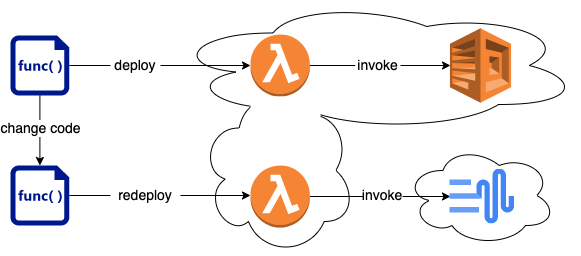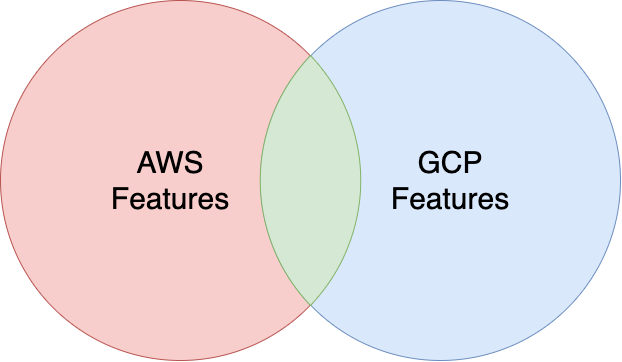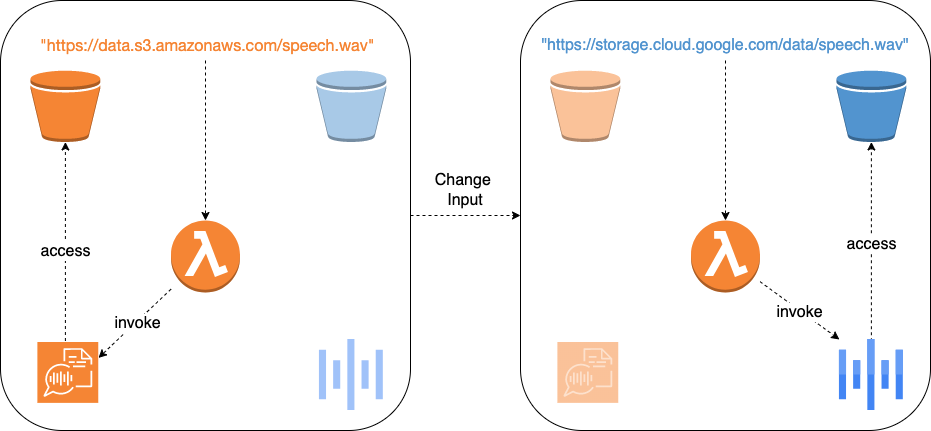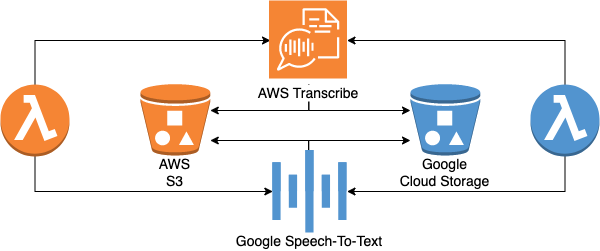CORE (core-once-run-everywhere) is an abstraction library for Speech-To-Text (S2T) and Text-To-Speech (T2S) services, that hides the differences between cloud providers, by offering a unified and simple interface for the most common use-cases. Developers can work with abstract service types during development, while the concrete services are dynamically selected at runtime. Migration of a service from one provider to another does not require code changes and only a single version of the code is needed for the deployment on multiple providers, which significantly reduces development effort. Although there are existing abstraction libraries (e.g. LibCloud, jClouds) that provide a unified interface for cloud services, they focus on infrastructure services (e.g. compute, network, storage) and there is no library for S2T and T2S services. As those two services are typically used together, CORE is a perfect fit for many use cases like speech translation, voice control and many more. Furthermore, functionality is added to automatically infer and configure a provider (e.g. based on the location of the input file or supported features). This means that it provides higher level of abstraction compared to other libraries, as custom initialization logic is provided by the library itself.
The following section describes the benefits of using CORE compared to provider-specific SDKs and existing abstraction libraries.
Users may want to switch the provider of BaaS services (e.g. due to accuracy or costs) by replacing a service with another providers service of the same type, while preserving initial functionality. Using provider-specific SDKs, migrating a service from one provider to another requires a high development effort. For example, switching from AWS Polly to Google Text-To-Speech involves learning a new SDK, rewriting the code and redeploying the function to the new provider.
To bridge this gap, CORE offers a unified interface for both providers, which allows to switch the provider by simply changing an input parameter. Migration of a service from one provider to another does not require code changes and only a single version of the code is needed for the deployment on multiple providers, which significantly reduces development effort.
// run the service on AWS
speechSynthesizer.synthesizeSpeech(request,Provider.AWS);
// run the service on GCP
speechSynthesizer.synthesizeSpeech(request,Provider.GCP);In addition, CORE offers a unified input and output format for all providers, so handling the data would not have to be adjusted depending on what provider was used. For example, Google Speech-To-Text specifies the word time offsets in ticks, where one tick is 100 ms, while AWS Transcribe reports the offsets in seconds. The results returned by the concrete services are mapped to a common schema to hide those differences from the user.
Users may want to use specific features that are only supported by a single provider. Some libraries (e.g. LibCloud) decide to make all features available to the user. Therefore, provider-specific knowledge is needed to avoid choosing a provider that does not support a certain feature. In practice, this results in special cased code. Other libraries (e.g. pkgcloud) decide to offer only the features supported by all providers. However, the surface area that is consistent across all providers decreases with increasing number of providers.
To bridge this gap, CORE dynamically selects the provider based on the desired features specified
by the user. For example, natural sounding speech should be generated from a text file. The desired audio format is OGG_VORBIS, which
is only supported by AWS Polly. In this case, the library will automatically infer the provider from the audio format.
// audio format only supported by aws
speechSynthesizer.synthesizeSpeech(request,SynthesisAudioFormat.OGG_VORBIS);If the audio format is changed to OGG_OPUS, the library will automatically switch to Google Text-To-Speech, as this
format is only supported by GCP.
// audio format only supported by gcp
speechSynthesizer.synthesizeSpeech(request,SynthesisAudioFormat.OGG_OPUS);Users may select a combination of features that cannot be handled by a single provider. For example, generating subtitles as part of the speech recognition process is only supported by AWS Transcribe, while profanity filter is only supported by Google Speech-To-Text. In this case, the service is invoked on both providers and the results are merged together. Merging of results is only possible for S2T and not for T2S, since it is not possible to merge audio files.
SpeechRecognitionFeatures features=SpeechRecognitionFeatures.builder()
.srtSubtitles(true) // only supported on AWS
.profanityFilter(true) // only supported on GCP
.build();
speechRecognizer.recognizeSpeech(request,features);Users may want to migrate a function that uses BaaS services from one provider to another. If we naively migrate the function, it still accesses the services of the old provider. Traffic is flowing from one cloud to another leading resulting in higher costs due to the providers pricing models. Furthermore, network proximity and transport costs may be increased, which impacts the performance.
To bridge this gap, CORE allows to dynamically select the provider and region where to run the service, based on the location of the data. For S2T, the input is audio and the output is text. Under the assumption that audio is larger than text, the service should be moved close to the input. AWS Transcribe and Google Speech-To-Text process the input directly from cloud storage. The library automatically detects where the storage bucket is located and invokes the service on the same provider and region.
For T2S, the input is text and the output is audio. Hence, the service should be moved close to the output. AWS Polly and Google Text-To-Speech do not support to write the result directly to cloud storage. Instead, the synthesized speech is returned to the function. Hence, the service should run close to the function. The library automatically detects where the function is running and invokes the service on the same provider and region. If the function is migrated to another provider the library will automatically select the new provider without the need for any code changes.
Users may want to migrate a service that itself uses another service from one provider to another. For example, Google Speech-To-Text should be migrated to AWS Transcribe and the input data is stored in Google Cloud Storage. Data movements may be required before invoking the service, since AWS Transcribe can not consume data directly from Google Cloud Storage. Therefore, the migration of chained BaaS services may involve code changes even though the services itself are portable, which results in a high development effort. For example, 8 deployment packages are needed, if a function that transcribes speech from an audio file that is stored in some cloud storage should be deployed on two providers.
To bridge this gap, the files are automatically moved internally if necessary. For example, an audio file that is stored in Google Cloud Storage should be transcribed and the service should run on AWS (e.g. due to accuracy or cost). AWS Transcribe process the input directly from an AWS S3 bucket, hence the library automatically moves the input file to a temporary S3 bucket before invoking the service.
SpeechRecognitionRequest request=SpeechRecognitionRequest.builder()
.inputFile("https://storage.cloud.google.com/bucketname/output.mp3")
// other parameters
.build();
speechRecognizer.recognizeSpeech(request,Provider.AWS);Another example would be that a text file that is stored in AWS S3 should be synthesized using ogg opus audio format. The desired audio format is only supported by GCP, but Google Text-To-Speech can not consume data from AWS S3. In this case, the library automatically downloads the input file before invoking the service.
SpeechSynthesisRequest request=SpeechSynthesisRequest.builder()
.inputFile("https://bucketname.s3.us-east-1.amazonaws.com/input.txt")
// other parameters
.build();
speechSynthesizer.synthesizeSpeech(request,SynthesisAudioFormat.OGG_OPUS);The library consists of two modules. One module for S2T and another module for T2S. Both modules follow a layered architecture. On top, the high level interface that is exposed to the user. Next, the logic which is required for abstracting the concrete cloud services. Below are the credentials, configuration and runtime, which are reused in both modules. The credentials contain the functionality for loading the credentials and provide methods for returning the credentials of a specific provider. The configuration can be used to configure default values (e.g. provider and region). Runtime provides methods for detecting the provider and region of the serverless function executing the code, or whether the code is running in a serverless environment at all. On the bottom, the provider-specific SDKs are used to connect to the concrete cloud services. Additionally, a storage abstraction is reused in both modules, which provides a unified interface for cloud storage services. The concrete services are Google Speech-To-Text, AWS Transcribe, Google Text-To-Speech, AWS Polly, Google Cloud Storage and AWS S3.
The SpeechRecognition interface defines the unified interface for all providers. The concrete provider specific
implementations are
contained in the SpeechRecognitionAmazon and SpeechRecognitionGoogle classes, that implement the SpeechRecognition
interface.
The SpeechRecognitionCombined runs the service on both providers and merges the result.
The SpeechRecognitionFactory is responsible for the creation of
providers and decides, which provider and region to use. It provides methods to select the provider based on features,
input location etc.
Finally, the SpeechRecognizer is intended to be used by the client code.
It is using the factory to automatically infer and configure a provider. The T2S service follows a similar
structure.
With this class structure in place, adding support for another provider can be done in the following steps. First, a new class implementing the SpeechRecognition interface has to be added, which must contain all the necessary code to make the remote calls to the newly supported provider. The credentials for the new provider must be added and the methods for loading the credentials must be adapted. Finally, the SpeechRecognitionFactory has to be extended to create and configure the new provider.
The recognizeSpeech method is overloaded three times. The first version allows to select the provider explicitly. The
second version allows to select the provider implicitly based on the features. The third version allows to select the
provider based on the location of the input file.
SpeechRecognitionResponse recognizeSpeech(SpeechRecognitionRequest request,Provider provider);
SpeechRecognitionResponse recognizeSpeech(SpeechRecognitionRequest request,SpeechRecognitionFeatures features);
SpeechRecognitionResponse recognizeSpeech(SpeechRecognitionRequest request); class SpeechRecognitionRequest {
String inputFile; // local filesystem, AWS S3, Google Cloud Storage
int sampleRate; // audio frequency in Hz
int channelCount; // 1 for mono and 2 for stereo
String languageCode; // W3C language code (e.g. en-US, de-DE, etc)
}class SpeechRecognitionResponse {
String fullTranscript; // transcript of the whole audio file
List<Word> words; // information about each detected word
String srtSubtitles; // subtitles in SRT format
String vttSubtitles; // subtitles in VTT format
}class SpeechRecognitionFeatures {
boolean srtSubtitles; // generate subtitles in srt format
boolean vttSubtitles; // generate subtitles in vtt format
boolean profanityFilter; // mask profane words with asterisk
boolean spokenPunctuation; // detect spoken punctuation (e.g. question mark)
boolean spokenEmoji; // detect spoken emojis (e.g. raised hand)
}class Word {
Double startTime; // duration from start of audio file to the beginning of the word in seconds
Double endTime; // duration from start of audio file to the end of the word in seconds
Double confidence; // confidence score between 0 and 1
String content; // the word itself
}The synthesizeSpeech method is overloaded three times. The first version allows to select the provider explicitly. The
second version allows to select the
provider implicitly based on the desired audio format. The third version allows to select the provider based on the
location of the function.
SpeechSynthesisResponse synthesizeSpeech(SpeechSynthesisRequest request,Provider provider);
SpeechSynthesisResponse synthesizeSpeech(SpeechSynthesisRequest request,AudioFormat audioFormat);
SpeechSynthesisResponse synthesizeSpeech(SpeechSynthesisRequest request);class SpeechSynthesisRequest {
String inputFile; // local filesystem, AWS S3, Google Cloud Storage
String language; // for example en-US or de-DE
TextType textType; // PLAIN_TEXT | SSML
Gender gender; // MALE | FEMALE
}class SpeechSynthesisResponse {
byte[] audio; // binary audio stream containing the synthesized speech
}A storage abstraction was developed, which offers a uniform interface to interact with all supported storage backends in the same way. As both libraries need to access files stored on multiple storage backends, this part was decomposed into a separate module, which can be reused by both libraries.
byte[] read(String fileUrl);
void write(byte[]data,String fileUrl);
boolean delete(String fileUrl);
String createBucket(String bucketUrl);
String deleteBucket(String bucketUrl);Files can
be uploaded, downloaded and deleted using the read(), write() and delete() methods. Additionally, storage buckets
can
be created and delete using the createBucket()and deleteBucket() methods. Files are specified by URLs, which are
automatically parsed to infer provider, region, bucket and file
name.
class FileInfo {
boolean isLocal; // true if the file is stored on the local filesystem
String fileName; // the name of the file
String fileUrl; // the complete url
BucketInfo bucketInfo; // information parsed from the bucket url
static FileInfo parse(String fileUrl); // parse file url
}class BucketInfo {
ProviderType provider; // the provider where the bucket is located
String location; // the geographical location of the storage bucket
String bucketName; // the bucket name
String bucketUrl; // complete the bucket url with trailing slash
static BucketInfo parse(String fileUrl); // parse bucket url
}Internally, files and buckets are represented as objects, which contain the information that was parsed from the URL. Additionally, there are static methods to parse URLs and convert them to objects.
The Credentials class offers static methods to load the credentials. loadFromFile() can be used to load the
credentials from anywhere on the filesystem. It can handle absolute paths or relative paths starting from the current
working directory. loadFromResourceFolder() takes a relative path starting from the
resource-folder. loadDefaultCredentials() searches for a credentials.json file in the resource-folder. All three
methods return a credentials object that is a wrapper around the credentials of all providers and offers getters for
obtaining the credentials of a specific provider.
Credentials loadFromFile(String path);
Credentials loadFromResourceFolder(String path);
Credentials loadDefaultCredentials();Default provider and regions can be overwritten in the configuration object, that is passed to the constructor of the service during initialization.
class Configuration {
Provider defaultProvider;
String defaultAwsRegion;
String defaultGcpRegion;
}The runtime object provides methods to detect in which runtime environment the code is running. getFunctionProvider()
returns the provider where the function is running or null, if the code is not running inside a serverless
function. getFunctionRegion() returns the geographical region where the function is located or null, if the code is
not running inside a serverless function.
Provider getFunctionProvider();
String getFunctionRegion();Invoking S2T services on AWS and GCP requires specifying a voice to use for synthesis. Each voice supports a specific language and gender. In order to relieve the user of the decision as to which voice should be used, all voices were queried in advance and saved in json files. The library automatically selects a voice that supports the desired language and gender by searching those json files. As a result, the user does not need to have provider specific knowledge about the voices and no additional request has to be made to query the voices on each invocation of the service.







